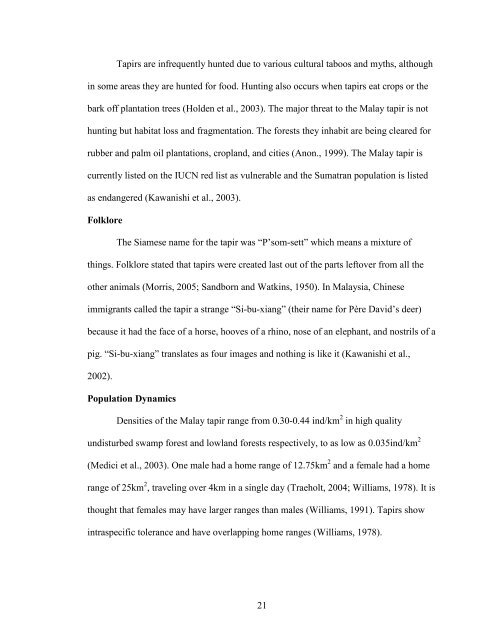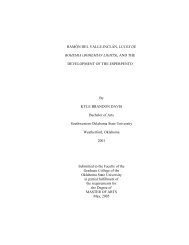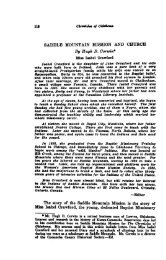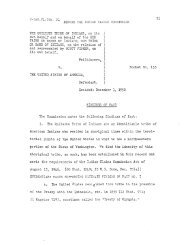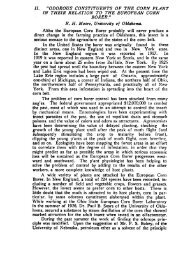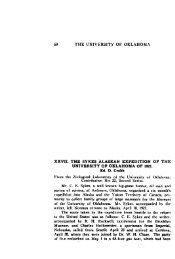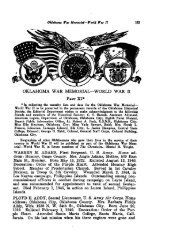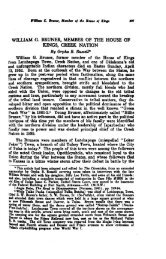tapir behavior- an examination of activity patterns, mother young ...
tapir behavior- an examination of activity patterns, mother young ...
tapir behavior- an examination of activity patterns, mother young ...
You also want an ePaper? Increase the reach of your titles
YUMPU automatically turns print PDFs into web optimized ePapers that Google loves.
Tapirs are infrequently hunted due to various cultural taboos <strong>an</strong>d myths, although<br />
in some areas they are hunted for food. Hunting also occurs when <strong>tapir</strong>s eat crops or the<br />
bark <strong>of</strong>f pl<strong>an</strong>tation trees (Holden et al., 2003). The major threat to the Malay <strong>tapir</strong> is not<br />
hunting but habitat loss <strong>an</strong>d fragmentation. The forests they inhabit are being cleared for<br />
rubber <strong>an</strong>d palm oil pl<strong>an</strong>tations, cropl<strong>an</strong>d, <strong>an</strong>d cities (Anon., 1999). The Malay <strong>tapir</strong> is<br />
currently listed on the IUCN red list as vulnerable <strong>an</strong>d the Sumatr<strong>an</strong> population is listed<br />
as end<strong>an</strong>gered (Kaw<strong>an</strong>ishi et al., 2003).<br />
Folklore<br />
The Siamese name for the <strong>tapir</strong> was “P’som-sett” which me<strong>an</strong>s a mixture <strong>of</strong><br />
things. Folklore stated that <strong>tapir</strong>s were created last out <strong>of</strong> the parts leftover from all the<br />
other <strong>an</strong>imals (Morris, 2005; S<strong>an</strong>dborn <strong>an</strong>d Watkins, 1950). In Malaysia, Chinese<br />
immigr<strong>an</strong>ts called the <strong>tapir</strong> a str<strong>an</strong>ge “Si-bu-xi<strong>an</strong>g” (their name for Père David’s deer)<br />
because it had the face <strong>of</strong> a horse, hooves <strong>of</strong> a rhino, nose <strong>of</strong> <strong>an</strong> eleph<strong>an</strong>t, <strong>an</strong>d nostrils <strong>of</strong> a<br />
pig. “Si-bu-xi<strong>an</strong>g” tr<strong>an</strong>slates as four images <strong>an</strong>d nothing is like it (Kaw<strong>an</strong>ishi et al.,<br />
2002).<br />
Population Dynamics<br />
Densities <strong>of</strong> the Malay <strong>tapir</strong> r<strong>an</strong>ge from 0.30-0.44 ind/km 2 in high quality<br />
undisturbed swamp forest <strong>an</strong>d lowl<strong>an</strong>d forests respectively, to as low as 0.035ind/km 2<br />
(Medici et al., 2003). One male had a home r<strong>an</strong>ge <strong>of</strong> 12.75km 2 <strong>an</strong>d a female had a home<br />
r<strong>an</strong>ge <strong>of</strong> 25km 2 , traveling over 4km in a single day (Traeholt, 2004; Williams, 1978). It is<br />
thought that females may have larger r<strong>an</strong>ges th<strong>an</strong> males (Williams, 1991). Tapirs show<br />
intraspecific toler<strong>an</strong>ce <strong>an</strong>d have overlapping home r<strong>an</strong>ges (Williams, 1978).<br />
21


